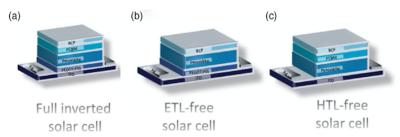Researchers from Professor Lioz Etgar's group at The Hebrew University of Jerusalem have recently studied the effects of electron transport layers (ETLs) and hole transport layer (ETLs) on the performance of inverted perovskite-based SC structures.

They focused on the inverted architecture, where the ETL and the HTL from the solar cell structure are eliminated. Three main architectures of were studied: a fully inverted structure, an ETL-free structure, and a HTL-free structure.
Finally, the photovoltaic (PV) performance of different solar cells shows that eliminating the HTL is most critical for PV performance, compared with ETL-free and fully inverted SC configurations.
Current-voltage hysteresis curves prove that efficient selective contacts are essential to eliminate this phenomenon. Measuring the ideality factor shows that the dominant mechanism in ETL-free SCs is surface recombination, whereas in the other cases, it is Shockley'Reed'Hall recombination. This new work provides knowledge about the functionality of methylammonium lead iodide as an electron conductor and as a hole conductor.



